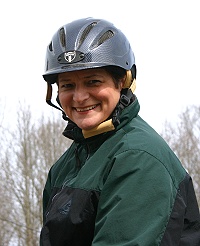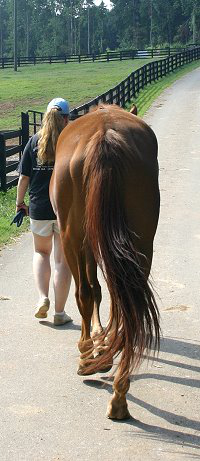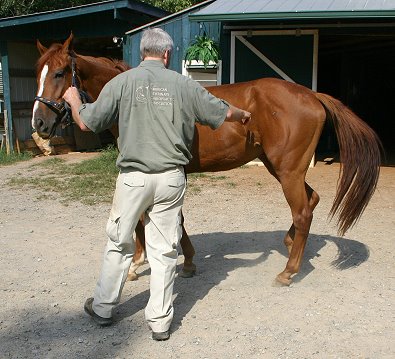Elizabeth Wood
photo by Phil West
Click here for more
TRAINING NOTES from Elizabeth
Click to print out a sheet of
chiropractic exercises
for your horse to help him feeling good.
Dr. Lance Cleveland's Web site is another good source for chiropractic information.
Click to print out a sheet of chiropractic
exercises for your horse to help him feeling good.
training notes from elizabeth |
Our horses > training notes from elizabeth > April12, 2007Our training notes often show schooling at the farm but may also include cross country schoolings and trail rides away from the farm. Go back through our notes to see how we train our off-the-track Thoroughbreds and prepare them for new careers as sport horses. The focus of this training note is on equine chiropractic care. How do I know if my horse needs chiropractic care?Most Off-the-track Thoroughbreds (OTTBs) need some chiropractic care. Their hips are slammed from behind in the starting gate, their heads are twisted sideways by the pony horse or on the hot walker. They are strong animals - they resist and pull muscles. Just as we humans can benefit from good chiropractic care, followed by stretching exercises to help us stay aligned, so do horses. Horses shows positive results much more quickly as their spinal column is not compressed like a human's. They become more relaxed and happy when they are not afraid of pain when being ridden. Signs of needing an adjustmentWatch the top of the tail it should move like a sideways the infinity sign with both sides being equal. If one side moves in a larger circle that is a sign that a hip is out of adjustment.
Trot your horse on a lunge line. Does one rear foot take a shorter step than the other? It may be very subtle. Does the horse not want to put weight on one of the rear legs as you are lunging in one direction or another? Does your horse drag a hind leg in the trot? It will look like a stifle problem. Does your horse struggles to do smooth downward
transitions – canter
to trot, trot to walk? Does your horse buck when you ride him? I am not talking about a head down between the legs - get off me rodeo buck. Does he buck up like a hop with both legs and then kick out to the side with one of the legs? This is classic of a horse whose hips are locked in extension. The muscles right behind the saddle become sore and can be painful. Imagine the horse has a sore back and the rider chooses to do a sitting trot! Ouch! - Buck, butt scoot. When asked to canter is the horse switching leads in the back? Does your horse suddenly scoot his butt under him and bolt? This could be a sign of a pinched nerve. Does your horse move unevenly showing possible lameness issues? Not all lameness issues can be solved by chiropractic but many are. If the lameness is related to a horse being out of alignment then an adjustment will show immediate improvement. When a hip or leg can not move freely as it should, other muscles are pulled and become sore. The horse then starts favoring his sore muscle. This leads to more problems in other body parts and sometimes lameness issues. It is important for you to evaluate your horse's movement before speaking with your vet. Watch the video below to see classic signs of a horse out of alignment. Many vets first suggestion is to lay up the horse because he is lame and needs rest. This is not a good idea if it is an alignment problem causing the lameness. That is why we do not suggest you put your newly purchased OTTB out to pasture. They will be sore when they come off-the-track. You need to work through the soreness and correct it with either veterinary care, chiropractic care or other alternative methods of treating soreness such as: acupuncture, lasers or magnets. You need to understand why the horse is not moving well and if it is an injury such as a strained tendon, then rest is the best option. It is obvious to most of us when a horse is not right - the hard part is finding out where he is hurting and determining, with your vet and chiropractor, which is the best solution. Video of horses showing signs of needing chiropractic adjustment
Here is a video of a horse that is out in the back. He shows all the classic signs. His buck is not a "get off me" buck but rather one where he is trying to stretch out the soreness by kicking out sideways. As soon as his head is raised he starts tail switching. The head being raised puts increased pressure on the back. Raise your head and feel it in your own back. Now image your back is sore and you have a rider bouncing on it. OUCH! Notice that the horse is cross firing when he picks up the canter and he bucks to get the front and rear legs on the same lead. He did not want to load the sore side so he used the other rear leg to get his balance and pick up the canter. Later when he is trotting you can see his stride is shorter on the left side. The owner of this video later comments that the horse had a muscle issue. The owner tried chiropractors but had no luck. Not all chiropractors know what they are doing. It is best to get referrals. It was a muscle issue and it was resolved by releasing the soreness. "well we tried chiro (3 times) equine touch...form of massage...nothing worked....we then had a final chance at a lady called lesley who does Equine Muscle Release Therapy, she did 3 and a half sessions and he's come on leaps and bounds (see my other more recent videos including a win at XC compeition)"
Click on the image above to watch a video found on YouTube to see some of these bucking issues which were resolved by chiropractic/massage therapy and good training methods. UPDATE: This video has been made Private by its creator. The horses in the first part of the video are exhibiting classic signs of being out of alignment: bucking with both legs hopping together or kicking out to one side with one leg and butt scooting because the nerves on the back are being pinched. These are not like the rodeo bucks of a horse that is trying to get rid of the rider. Getting a chiropractor to work on them and then exercising them to hold the adjustment is a quick way to help a horse that is bucking like these horses. The trainer in this video is a good rider and may have exercised the horses properly to help them align themselves. Exercises to help hold a horse's chiropractic adjustmentAt Bits & Bytes Farm each horse is evaluated on a monthly basis to see if chiropractic care is needed. After each adjustment the horses are lunged for a few days (or weeks if necessary) to help strengthen the muscles to hold the adjustment. We also do poll stretches, neck stretches, butt tucks and cross under exercises. Click here for a description of the exercises that you can start doing with your horse today to help keep him limber.
We do these exercises with each horse before he is ridden. We pay close attention to how they are moving when we are riding them and we watch each other's horses for signs that another adjustment may be needed.
We have spoken with many people who purchased OTTBs who did not believe in chiropractic. They used it as a last ditch effort to solve a lameness issue - It worked! We have many Success Stories that will tell of the results of getting a horse adjusted. Be nice to your horse and have a vet and a chiropractor check him out. This article is not to be used as a replacement to professional veterinary care. Always consult with your veterinarian if your horse is not doing well. At Bits & Bytes Farm each horse
is
evaluated to see if chiropractic care is needed. |
|
© 2009
Copyright Bits & Bytes Farm /Egeland Wood & Zuber, Inc. |







